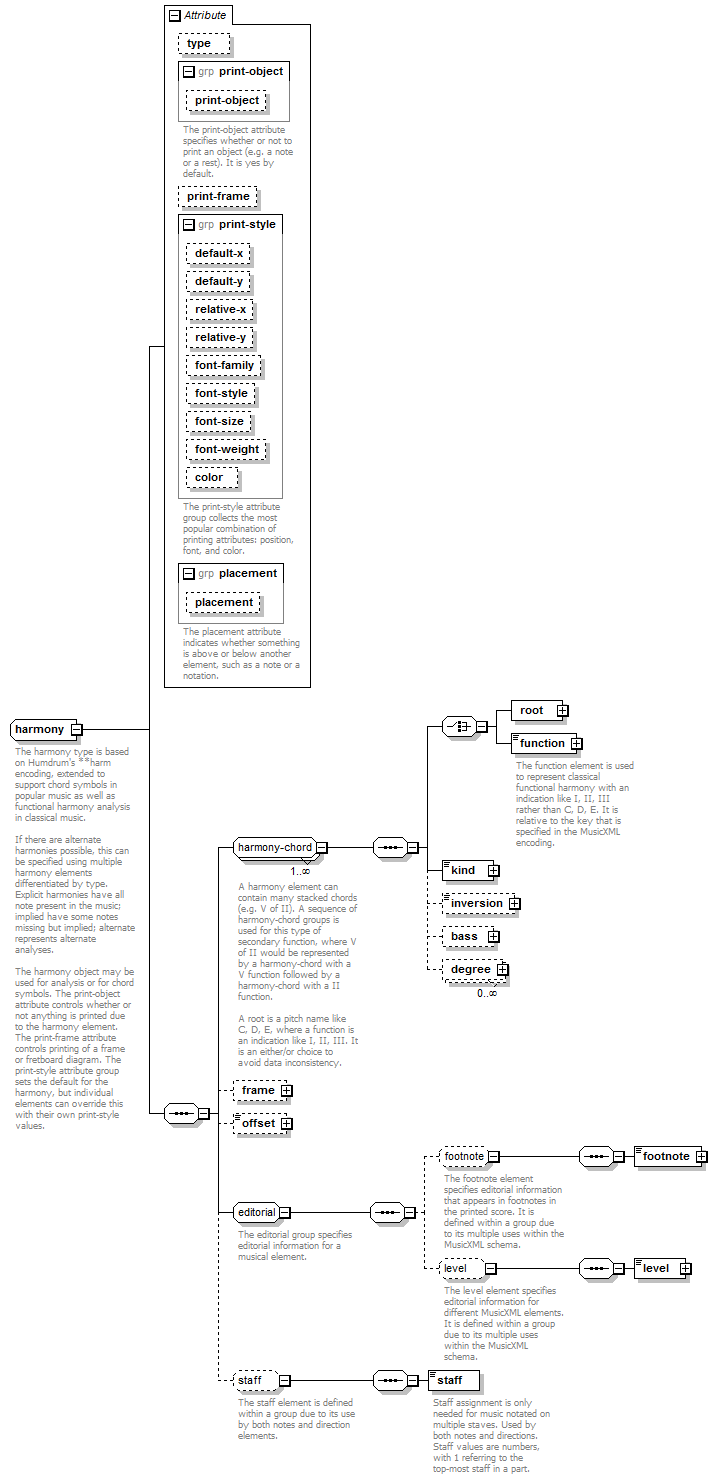harmony
The harmony type is based on Humdrum's **harm encoding, extended to support chord symbols in popular music as well as functional harmony analysis in classical music. If there are alternate harmonies possible, this can be specified using multiple harmony elements differentiated by type. Explicit harmonies have all note present in the music; implied have some notes missing but implied; alternate represents alternate analyses. The harmony object may be used for analysis or for chord symbols. The print-object attribute controls whether or not anything is printed due to the harmony element. The print-frame attribute controls printing of a frame or fretboard diagram. The print-style attribute group sets the default for the harmony, but individual elements can override this with their own print-style values. |
Complex Type Information
Model
(root | function) , kind , inversion{0,1} , bass{0,1} , degree* , frame{0,1} , offset{0,1} , footnote , level , staff

Attributes
| QName | Type | Fixed | Default | Use | Inheritable | Annotation |
|---|---|---|---|---|---|---|
| color | color | optional | ||||
| default-x | tenths | optional | ||||
| default-y | tenths | optional | ||||
| font-family | comma-separated-text | optional | ||||
| font-size | font-size | optional | ||||
| font-style | font-style | optional | ||||
| font-weight | font-weight | optional | ||||
| placement | above-below | optional | ||||
| print-frame | yes-no | optional | ||||
| print-object | yes-no | optional | ||||
| relative-x | tenths | optional | ||||
| relative-y | tenths | optional | ||||
| type | harmony-type | optional |
Used By
| Element | music-data/harmony |
Source
<xs:complexType name="harmony"> <xs:annotation> <xs:documentation>The harmony type is based on Humdrum's **harm encoding, extended to support chord symbols in popular music as well as functional harmony analysis in classical music. If there are alternate harmonies possible, this can be specified using multiple harmony elements differentiated by type. Explicit harmonies have all note present in the music; implied have some notes missing but implied; alternate represents alternate analyses. The harmony object may be used for analysis or for chord symbols. The print-object attribute controls whether or not anything is printed due to the harmony element. The print-frame attribute controls printing of a frame or fretboard diagram. The print-style attribute group sets the default for the harmony, but individual elements can override this with their own print-style values.</xs:documentation> </xs:annotation> <xs:sequence> <xs:group ref="harmony-chord" maxOccurs="unbounded"/> <xs:element name="frame" type="frame" minOccurs="0"/> <xs:element name="offset" type="offset" minOccurs="0"/> <xs:group ref="editorial"/> <xs:group ref="staff" minOccurs="0"/> </xs:sequence> <xs:attribute name="type" type="harmony-type"/> <xs:attributeGroup ref="print-object"/> <xs:attribute name="print-frame" type="yes-no"/> <xs:attributeGroup ref="print-style"/> <xs:attributeGroup ref="placement"/> </xs:complexType> |